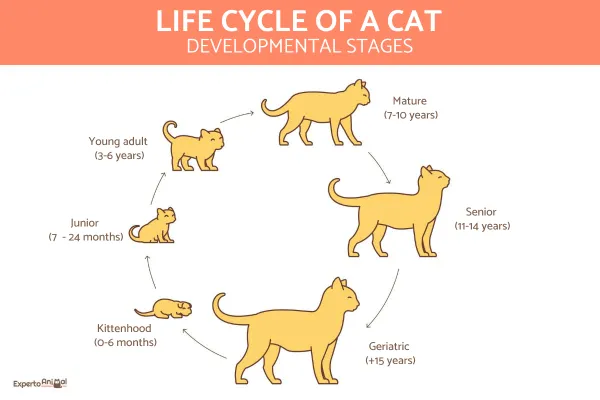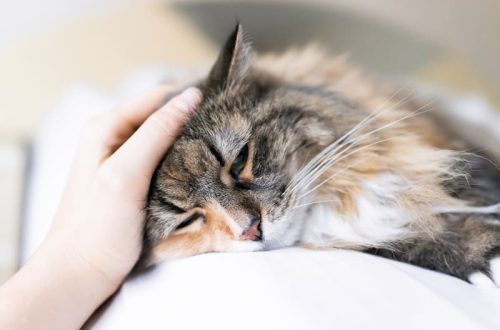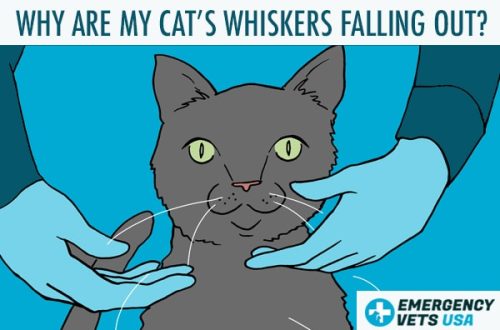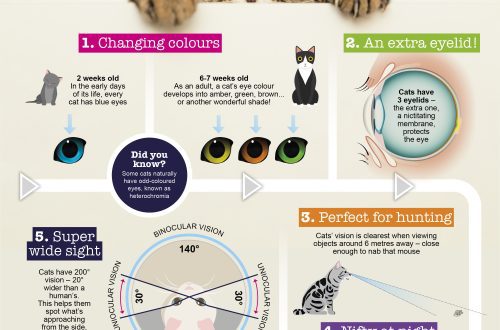
Mangsa utama kahirupan ucing
A cat in its development goes through several periods: infancy, childhood, adolescence, adulthood, old age. You need to know about this in order to better understand your pet and properly care for him at every stage of life.
Daptar eusi
Cat infancy (up to 4 weeks)
When a kitten is born, it weighs about 100 grams. The baby is born deaf and blind, but feels maternal warmth and tries to crawl closer. In the first two days, it is important for a kitten to drink “first milk” (colostrum), as it contains the necessary protective antibodies. Even kittens at the age of 1 day can purr. During the first week of life, babies either sleep or suckle milk. And in 1 days they almost double their weight. At 7 weeks, kittens begin to open their eyes and straighten their ears. But they still don’t see very well. The eyes of babies are blue and change color later. Already at the age of two weeks it is useful to start socializing a kitten: carefully pick it up and talk in an affectionate voice. At 2 weeks, kittens learn to stand on their paws and crawl. The first independent environmental studies begin. At 3 weeks, the eyes fully open and milk teeth appear. The sense of balance develops, kittens play with each other, arrange comic brawls. Toddlers at this age are learning to lick themselves.
Early childhood of a cat (5 – 10 weeks)
At 5 weeks, kittens improve their sense of balance, and all the senses are already operating at full strength. Kittens begin to taste solid food, milk teeth continue to grow. Babies experiment by burying the results of their life in the tray and scraping its walls and bottom. At 6 weeks the mother begins to “wean” the offspring, and by 9 weeks the kittens are completely on independent nutrition. The weight of a 7-week-old kitten is almost 7 times its birth weight. At 7 weeks, the baby acquires a full set of milk teeth. The kittens arrange hunting games , comic fights and begin to establish a hierarchy. At 10 weeks, the kitten already acquires the agility and grace of an adult cat, confidently runs, jumps and climbs.
Cat childhood (3 – 6 months)
The kitten’s eyes change color to “adult”, and it is already possible to clearly determine the color of the coat. Milk teeth are replaced by permanent ones. At 4 months (according to some experts, even earlier), the “socialization window” closes, and the character and personality of the kitten are established. At 5 months kittens begin to mark the territory, leaving odorous “signs”. At 6 months, signs of sexual maturity appear. Some prefer to sterilize a pet at this age in order to prevent unwanted reproduction.
Youth of a cat (7 – 12 months)
Kittens are still growing, but growth rates are slowing down. Cats reach sexual maturity. Long-haired cats acquire a full, constant length of coat. The cat sets a clear routine for herself, gets used to the environment and other pets.
Adult cat (over 1 year old)
As a rule, a cat experiences the heyday of life from 1 year to 9 years. However, this scheme is only approximate, and each pet deserves an individual “measurement”. If you properly care for the cat and she is healthy, she will delight you with cheerfulness and activity for many years. Signs of a cat’s health: clean, clear eyes, shiny coat, activity, dexterity, complaisance. The body temperature of a cat normally ranges from 38,6 – 39,2 degrees. Do not forget that the psychological well-being of a cat is no less important than the physical one. In an environment of love and in the absence of stress, a cat has every chance of staying healthy and alert for much longer. To better understand the condition of a cat, you can correlate the age of your pet with a human. One of the calculation options:
| Appropriate age of the person | Umur ucing | Appropriate age of the person | |
| taun 1 | 15 taun | 12 taun | 64 taun | |
| 2 taun | 24 taun | 14 taun | 72 taun | |
| 4 taun | 32 taun | 16 taun | 80 taun | |
| 6 taun | 40 taun | 18 taun | 88 taun | |
| 8 taun | 48 taun | 20 taun | 96 taun | |
| 10 taun | 56 taun | taun 21 | 100 taun |





